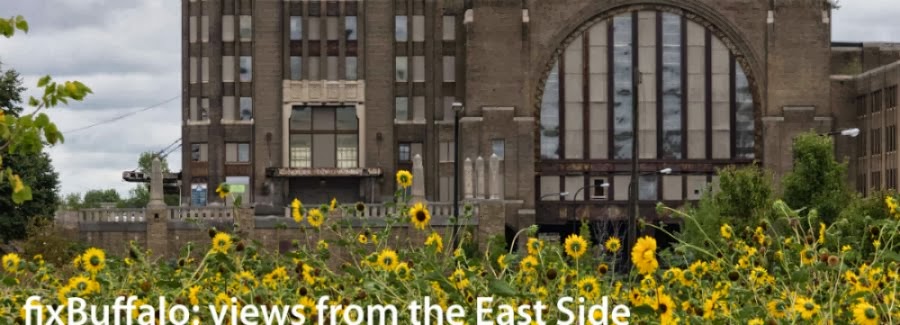On Saturday afternoon 75 cyclists and a car full of Canisius College students, driven by their philosophy professor, looped through parts of Buffalo's East Side on the latest stage of the Tour de Neglect. The tour, part of the week long CNU22 conference held in Buffalo, was one of a series of events promoted by CNU's NextGen crew, here.

The most important event during this year's Congress for the New Urbanism wasn't in a convention center. It was a guided bike tour through Buffalo's East Side. - CityLab

The planned stops included: St Anne's on Broadway, the former and now abandoned Sacred Heart Catholic Church on Emslie, Larkin Square, the Larkin Power House, Central Terminal and the Wilson Street Urban Farm. At each stop we were met by key community stakeholders. We had the unique opportunity to see the interior of Sacred Heart and witness the devastating and dis-heartening results of years of institutional neglect. The Central Terminal remains one of the city's best loved buildings and is home to a wildly successful ethnic festival, Dyngus Day and a long list of civic celebrations and events.
The Wilson Street Urban Farm is an island in the emerging archipelago of change on the city's East Side. In the past five years the Stevens family has transformed a forgotten street and has literally changed a neighborhood and re-built a community.
Buffalo Bicycle Share was a NextGen sponsor and generously provided bicycles for the tour. At the last minute a dozen local residents gave up their bikes for out of town folks who wanted to ride and see what some have simply described as oceanic devastation.
And now for the reviews...
CityLab - a CNU22 Media Sponsor - covered the tour, Riding through poor neighborhoods with New Urbanists and called it the most important event at CNU22.
James Howard Kunstler wrote about the tour in That was Then, This is Now. I'd invited Jim to ride with us and during the tour he told me that the Tour de Neglect was the most important session he'd attended.
Additional pics of Saturday's Tour de Neglect
Future Tour de Neglect schedule: TBA
Related: Additional #CNU22 pics
__________________________________________________________________________________The Wilson Street Urban Farm is an island in the emerging archipelago of change on the city's East Side. In the past five years the Stevens family has transformed a forgotten street and has literally changed a neighborhood and re-built a community.
Buffalo Bicycle Share was a NextGen sponsor and generously provided bicycles for the tour. At the last minute a dozen local residents gave up their bikes for out of town folks who wanted to ride and see what some have simply described as oceanic devastation.
This tour was designed to spark a broader conversation among urbanists about their potential role in bringing back distressed neighborhoods. The intent of the tour was not to expose deficiencies in the new urbanism, but to highlight a vast part of the city which is still neglected and desperate for attention, and is very much like so many historic, culturally-rich places in our legacy cities. Low-income neighborhoods can benefit greatly from the better neighborhoods that good urban principles can help create. We didn't bring people through the East Side to identify solutions, but to raise awareness and create a dialog.
The Tour de Neglect was one of three tours that included Buffalo's East Side,—two others hit up the Belt Line, which partially included the East Side, and the Hamlin Park Historic District, a middle class enclave which hugs Main St. These three tours, including mine, were all organized by people involved in CNU NextGen, a group of young professionals that typically hold unsanctioned, off-the-schedule events each year of the congress. This year, CNU generously added NextGen's set of events to its printed program—basically allowing the group to bypass the local host committee's process. Otherwise, the East Side—the elephant in the room here in Buffalo—would have been swept under the rug.
In spite of the population loss and huge challenges on Buffalo's East Side—census tracts lost as much as 89% of their population since 1950—the neighborhood has what suburban Orlando does not: a rich history and culture, walkable streets and blocks, access to public transit, narrow lots, and neglected landmarks awaiting restoration. I'd challenge any new urbanist development in Florida to match the terminating vista afforded by Buffalo's vacant Central Terminal. I bet no new urbanist development anywhere has barbecue as good as it is at Sodapops on Herman St.
America can no longer afford to build sprawl with porches. If the revival of distressed cities does not become the mission of the Congress for the New Urbanism, the movement will become irrelevant. The vast empty landscape of Buffalo's East Side is a challenge to new urbanist practitioners to never again do greenfield development within 30 miles of a disinvested historic city or town. To do so has always been hypocrisy, but this hypocrisy is especially egregious now that America has entered, as Andrés Duany put it, "the century of limits."
And now for the reviews...
CityLab - a CNU22 Media Sponsor - covered the tour, Riding through poor neighborhoods with New Urbanists and called it the most important event at CNU22.
James Howard Kunstler wrote about the tour in That was Then, This is Now. I'd invited Jim to ride with us and during the tour he told me that the Tour de Neglect was the most important session he'd attended.
Additional pics of Saturday's Tour de Neglect
Future Tour de Neglect schedule: TBA
Related: Additional #CNU22 pics


No comments:
Post a Comment